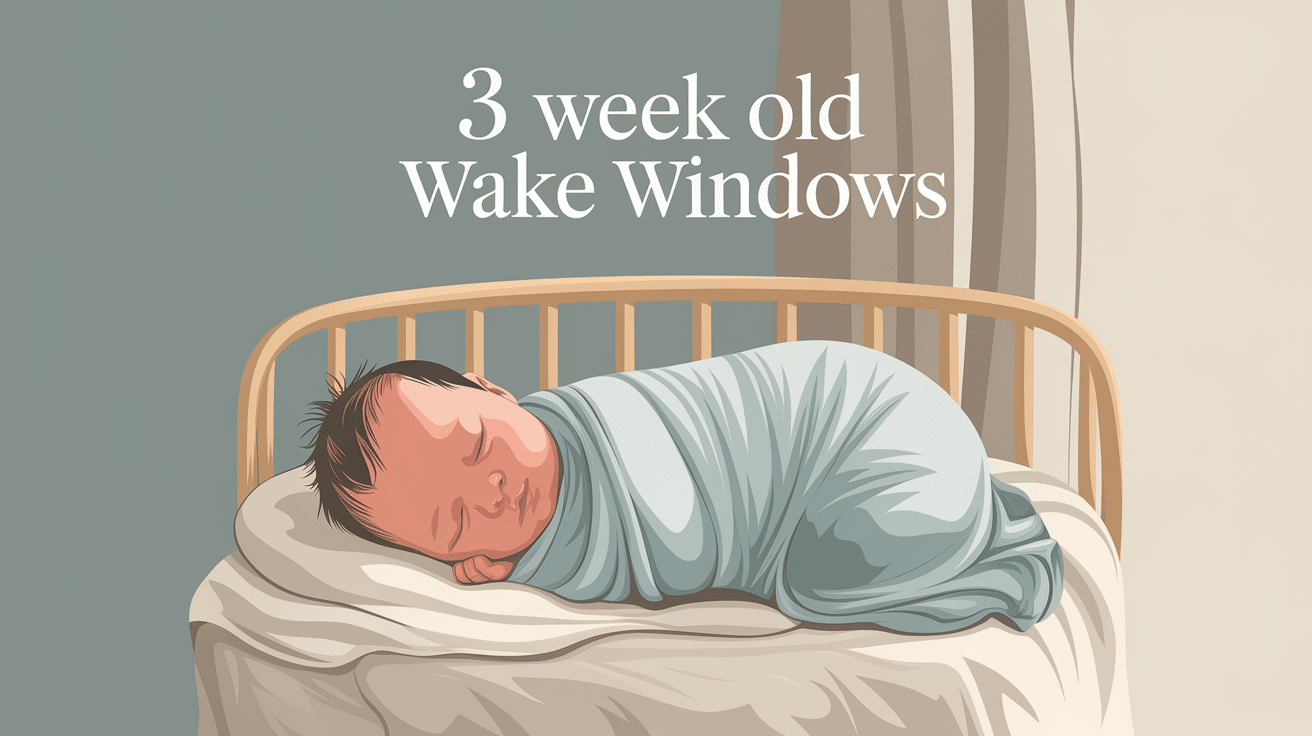
Why does your little one seem to nap in such tiny chunks? Nature has a plan! Baby sleep follows unique patterns that parents can learn to work with rather than fight against.
Your newborn’s growing brain needs plenty of rest. At just three weeks old, understanding your baby’s wake windows can help ease daily routines and build healthy sleep habits for your whole family.
Surprising fact! Newborns actually spend about 50% of their sleep time in REM sleep (compared to just 20% for adults).
Watch for sleepy signs like gentle eye rubs, turning away, or small yawns. These tell you your baby has reached its limit of being awake, typically just 45-60 minutes for very young infants.
Responding to these cues promptly helps prevent overtiredness and those tricky bedtime battles that leave everyone exhausted.
Learning this natural rhythm creates calmer days and more restful nights for your growing baby.
The Magic of Newborn Sleep: Understanding Wake Windows
Tiny eyes flutter open, gazing at a world still so new. At just three weeks old, your baby’s sleep patterns might seem mysterious, but they hold the key to calmer days ahead.
Newborns typically stay awake for very short periods before needing rest again. These brief “wake windows” are nature’s way of helping their developing brains process new information without becoming overwhelmed.
Newborns spend about 16-18 hours sleeping each day, but rarely more than 3-4 hours at once.
Recognizing your little one’s sleep cues—yawning, eye-rubbing, or becoming fussy—helps you identify their optimal wake window. Putting them down during this sweet spot can transform your daily routine from chaotic to manageable.
Honoring these natural rhythms can help you and your baby find more peace in those precious early weeks together.
Sleep Patterns for Your 3-Week-Old

When your tiny stargazer first enters the world, its sleep rhythm dances to its unique beat! At three weeks, most babies stay awake for just 30-60 minutes between naps.
Watch for those sleepy signals: rubbing eyes, turning away, or those adorable little yawns. These are your baby’s way of saying, “I’m ready for dreamland!”
Did you know? Newborns spend about 16-17 hours sleeping each day, but in short bursts rather than long stretches.
Every baby writes their own sleep story. Some little ones need shorter wake windows, while others thrive with a bit more awake time. Let your baby be your guide and adjust accordingly.
Remember that consistency builds comfort. Though challenging at first, responding to your baby’s sleep cues helps establish healthy patterns that will serve you both in the months ahead.
Wake Windows: The Key to Happy Sleep at 3 Weeks Old

Finding your baby’s rhythm during this time helps establish healthy sleep foundations that can benefit your family for months to come.
When your baby stays awake for the right amount of time, you’re setting them up for sleep success. Too long awake and they become overtired, making it harder for them to settle down.
Their little bodies produce stress hormones that work against sleep, turning what could be peaceful naps into frustrating battles.
Following age-appropriate wake windows encourages the delicious, lengthy naps your baby needs. Quality sleep isn’t just about tonight—it supports crucial brain development happening at lightning speed during these early weeks.
Wake windows also create predictable patterns for feeding and play, helping your baby feel secure in their new world. With the right balance, you’ll enjoy more smiles and fewer tears!
Tracking Your 3-Week-Old’s Wake Windows

The simplest tracking method is observation—watch for eye rubbing, fussiness, or yawning. These cues signal that your little one is ready for sleep.
Digital options include baby tracker apps that record sleep/wake patterns with just a tap. Many parents also find that a simple journal works perfectly.
A typical day might include:
| TIME | ACTIVITY |
|---|---|
| 7:00 AM | Morning wake-up |
| 7:45 AM | First nap |
| Throughout Day | 45–60 minute wake windows |
| Evening | Cluster feeding |
| 10:00 PM | Longer sleep stretch begins |
Remember that each baby develops their unique rhythm. The key is consistency and responding to your baby’s individual needs rather than forcing a strict schedule too early.
Common Sleep Mistakes Parents Should Avoid
Respecting your baby’s natural rhythm is crucial for healthy sleep development. Pushing longer wake windows too early can lead to overtiredness, making it harder for your little one to settle down.
Learning to spot sleepy signals takes practice. Yawning, eye rubbing, and decreased activity are your baby’s way of communicating they’re ready for rest. Missing these cues often results in crankiness and difficult bedtimes.
Many parents unknowingly overstimulate their babies during awake periods. Bright lights, loud noises, and too many activities can overwhelm their developing nervous system. Instead, aim for calm, age-appropriate activities that engage without overwhelming.
Understanding these patterns helps create a more peaceful sleep for both you and your baby.
Common Mistakes
-
Keeping your baby awake too long in hopes that they’ll sleep longer often backfires and leads to overtiredness.
-
Overstimulating your 3-week-old with too many toys or noise during wake time can make it harder for them to wind down.
Tips to Make the Most of Wake Time
Gentle tummy time strengthens your baby’s neck and shoulder muscles while creating valuable bonding moments. Place colorful toys within reach to encourage movement and exploration.
Visual and sensory stimulation helps develop your baby’s growing brain. Try high-contrast black-and-white patterns, soft-textured toys, or gentle music to engage their senses without overwhelming them.
Create meaningful connections through quiet bonding activities. Gentle face-to-face interaction, soft singing, or reading simple board books create a foundation of security and trust. Remember to watch for sleepy cues to avoid overtiredness.
These wake time activities provide crucial developmental benefits while nurturing your special relationship. Keep sessions brief and enjoyable, following your baby’s lead and energy levels for the most positive experience.
Special Tip: Follow your baby’s cues and end wake time with a calming routine to help them transition smoothly into restful sleep.
When to Adjust Wake Windows?
Watch for changes in sleeping habits following vaccination or medication, as these can impact your baby’s rest needs.

1. Growth Spurts & Development Milestones
Your child’s sleep needs grow with their rapid development. Sudden changes in appetite, mood, or sleep patterns often signal a growth spurt, requiring wake window adjustments.
During these growth periods, babies may need either more sleep to support physical development or more awake time to practice new skills. Developmental leaps like rolling, sitting, or crawling can temporarily disrupt sleep as their brain processes these exciting milestones.
2. Reading Baby’s Cues
Watch for signs of overtiredness, such as eye rubbing, fussiness, or looking away. Notice signs of undertiredness, too, such as fighting sleep, short naps, or early waking.
Timing is everything—a yawn or decreased activity might indicate your baby is entering its ideal sleep window. Responding promptly to these subtle signals before they escalate to crying helps maintain the baby’s natural sleep rhythm.
3. Welcoming Flexibility
A responsive approach works better than rigid schedules. Some days, your baby might need more awake time, while other days, it might need less.
Remember that each child develops uniquely. What works for one baby might not work for another, so trust your instincts while paying attention to your baby’s changing needs throughout their development trip.
Summing It Up
A newborn’s sleep journey is both simple and complex. At three weeks old, your baby thrives with short periods of wakefulness—typically under an hour before needing rest again.
By watching for gentle hints, such as eye rubs or tiny yawns, you’ll catch the perfect moment for sleep before fussiness takes over.
These natural sleep patterns aren’t just about making your days smoother (though that’s a welcome bonus!). They support crucial brain growth, which happens at remarkable speed during these early weeks.
By honoring these natural cycles while staying adaptable, you create a nurturing foundation for healthy sleep habits. The time you invest now in understanding these patterns will benefit your little one’s development for months to come.
If you’re interested in more informational content on mothers and babies, feel free to click here and explore other blogs that you might enjoy.

